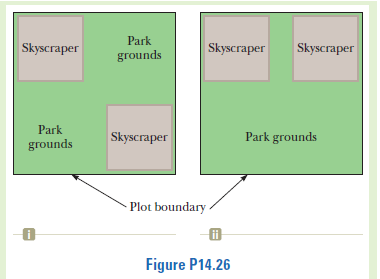Park Skyscraper Skyscraper Skyscraper grounds Park Skyscraper Park grounds grounds Plot boundary Figure P14.26
You are working as an expert witness for the owner of a skyscraper complex in a downtown area. The owner is being sued by pedestrians on the streets below his buildings who were injured by falling glass when windows popped outward from the sides of the building. The Bernoulli effect can have important consequences for windows in such buildings. For example, wind can blow around a skyscraper at remarkably high speed, creating low pressure on the outside surface of the windows. The higher atmospheric pressure in the still air inside the buildings can cause windows
to pop out. (a) In your research into the case, you find some overhead views of your client’s project, as shown below. The project includes two tall skyscrapers and some park area on a square plot. Plan (i) as shown was submitted by the original architects and planners. At the last minute, the owner decided he didn’t want the park grounds to be divided into two areas and submitted Plan (ii) as shown, which is the way the project was built. Explain to your client why Plan (ii) is a much more dangerous situation in terms of windows popping out than Plan (i). (b) Your client is not convinced by your conceptual argument in part (a), so you provide a numerical argument. Suppose a horizontal wind blows with a speed of 11.2 m/s outside a large pane of plate glass with dimensions 4.00 m × 1.50 m. Assume the density of the air to be constant at 1.20 kg/ m3. The air inside the building is at atmospheric pressure. Calculate the total force exerted by air on the windowpane for your client. (c) What If? To further convince your client of the problems with the building design, calculate the total force exerted by air on the windowpane if the wind speed between the buildings is 22.4 m/s, twice as high as in part (b).

Trending now
This is a popular solution!
Step by step
Solved in 4 steps with 3 images









